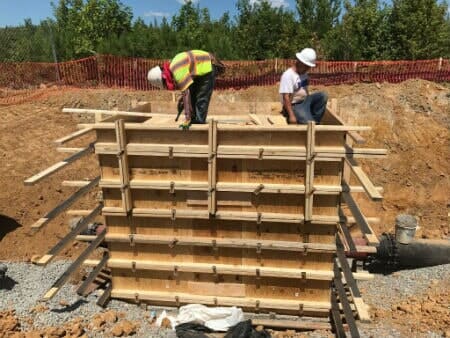
The construction industry employs approximately 7.5million workers. It is divided into three categories -- specialty trade contractor, construction of building, and heavy- and civil engineering. With more than half (485,000.00) of the expected new jobs coming from the specialty trade contractors segment, job growth is expected to continue through 2026.
Experience, willingness to get the necessary licenses, certifications and education are all key factors in construction workers' job prospects. Those who enter specialties that require specific education or training, such as crane operators, should have the best opportunities for securing a good job with good pay and benefits.
While residential construction is expected not to pick up, it may increase the number of jobs for those who are skilled in maintaining interior systems. This is particularly true for line installers as well as heating and air conditioning mechanics and installs.
Nonresidential construction should also offer a number of employment opportunities. It is possible to expect more retail and office building, and more jobs in schools and hospitals.

As the economy continues its recovery, it might be beneficial for construction workers to earn a bachelor’s degree in a related area, such as architecture, construction science with an accent on management, or any other similar field. This will ensure that professionals are able to meet the growing demands of this rapidly-growing field.
Construction managers need to know how to coordinate and effectively manage projects from start to finish. They can also help other workers do their jobs more efficiently by sharing their knowledge.
As infrastructure declines and population increases, the number of construction jobs will rise. Need for skilled labor will increase with the construction of new schools, office buildings, and hotels as well redevelopment of old ones.
Higher wages and promotions are available to those who already work in the field. This is especially important if you have been in the business of construction for a long time.
Construction workers now have a 3.7% unemployment rate, down from 4.2% in November 2018. This decline is due to lower interest rates, and the recent housing crash that made homeownership more costly.

However, construction workers should be ready for a potential recession. If the recession comes as expected, construction workers could see their jobs lost or their wages reduced.
These negatives aside, the industry of construction is expected to grow by 4 percent between 2021 and 2031. The increased demand and need for infrastructure will fuel this growth, as will the need to replace workers who are leaving their professions permanently. A high percentage of job losses (including retirements, layoffs and quits) will result in a rise in employment.
FAQ
What happens when one party refuses to take their side in a deal?
Failure to keep your promises can result in the law permitting the other party to sue you and treat your promise as null. Damages include the amount due plus interest, court cost, and legal fees.
Who is responsible for a Service Agreement
Your service agreement with your customer defines the services you will offer them. It describes the customer's responsibilities as well as what you can do for them and when they must pay you.
You will be informed in the service agreement if any additional fees apply for services that are not included.
All terms and conditions of a service agreement must be included. This includes payment terms, delivery times, warranties, and the like.
This template will help you cover all aspects of the agreement.
What is a service-contract agreement?
A Service Contract Agreement (SCA), is an agreement between the parties to provide services. The SCA defines the services and determines how much effort and time should be spent on them. It also specifies who pays for them and when and where they should start. The SCA also describes what happens if either side violates its obligations.
Statistics
- (v) Place or places of performance of the prime contract and first-tier subcontracts estimated at $10 million or more, if known. (acquisition.gov)
- (ii) Name, address, and telephone number of each proposed first-tier subcontractor with a proposed subcontract estimated at $10 million or more. (acquisition.gov)
- (1) Ascertain the extent to that offers are based on the payment of overtime and shift premiums; and (2) Negotiate contract prices or estimated costs without these premiums or obtain the requirement from other sources. (acquisition.gov)
- Don't take their anger personally, they are mad about the situation 99% of the time. (activatemylicense.com)
- Reasonable late fees go up to 25% per year on unpaid sums. (lawdepot.com)
External Links
How To
What's the difference between a service contract and a service agreement?
A service arrangement is an agreement whereby a provider agrees with a customer to perform services. It creates an obligation on both parties. The term "service" refers to a company's products, information, advice, etc., but does not include financial services.
Contracts are legally binding documents that outline the terms and conditions of business relationships. If you buy a product directly from a retailer, you've entered into a contractual agreement. You have the right to make payment for the item in due time. If you accept employment, you have entered into a contract with your employer.
No formal documentation is required for a service agreement. A service agreement written is not often used in practice. Instead, verbal agreements are standard.
But, a service agreement is more advantageous than a contract.
-
A service agreement allows for greater flexibility than a contract.
-
It allows a service supplier to change its mind and not be penalized.
-
It gives the service more freedom in how it delivers the agreed-upon services.
-
It is a clear record that demonstrates what was said.
-
It is easier for a service provider to be sued.
-
It is much cheaper to write a service contract than a standard contract.
-
It is less likely for it to result in litigation.
-
It is much easier to terminate a service contract than a contractual agreement.
-
It is more simple to amend a service agreement than a standard contract.
-
It is possible to use a service agreement for an ongoing relationship.
-
It is possible to divide the cost of drafting service agreements with third parties.
-
It is possible to include a clause requiring arbitration in a service agreement.
-
You can include provisions about confidentiality, nondisclosure, or proprietary rights.
-
It is possible to specify the duration (e.g., for one year).
-
It is possible to subject the service agreement to a condition precedent.
-
It is possible to say that the service provider is liable only for negligence or gross negligence.
-
It is possible, however, to limit liability for consequential losses.
-
It is possible for the service supplier to enter into another contract with a different customer.
-
Under certain circumstances, it is possible to give notice that you are terminating your contract.
-
It is possible for the service provider to offer a warranty.